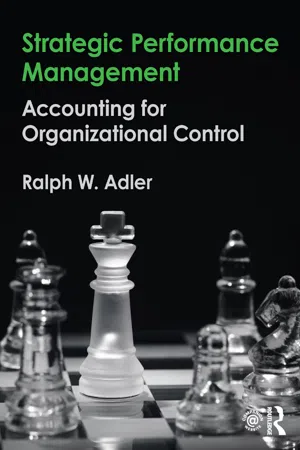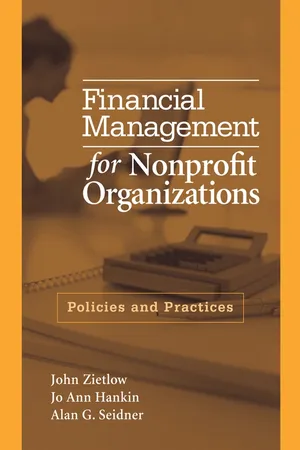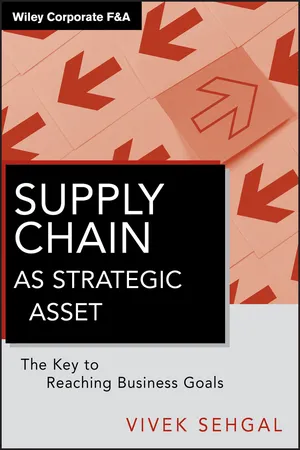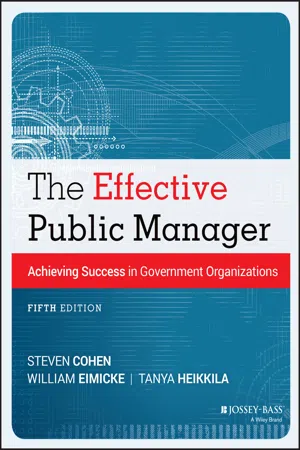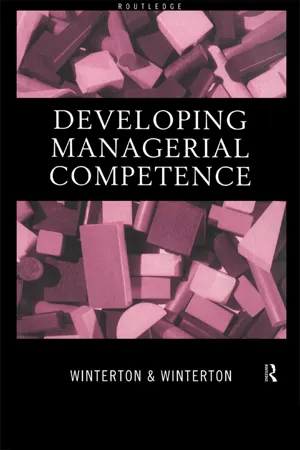Business
Organizational Strategy
Organizational strategy refers to the long-term plan of action designed to achieve specific goals within a business. It involves making decisions about how resources will be allocated and how the organization will position itself to gain a competitive advantage. This strategic framework guides the company in making choices that align with its overall mission and vision.
Written by Perlego with AI-assistance
Related key terms
Related key terms
1 of 4
Related key terms
1 of 3
11 Key excerpts on "Organizational Strategy"
- eBook - ePub
Strategic Performance Management
Accounting for Organizational Control
- Ralph W. Adler(Author)
- 2018(Publication Date)
- Routledge(Publisher)
Long Range Planning. The centrality of time to the concept of strategy is captured by Miyamoto (1974: 21), who argues for the need “to see distant things as if they were close and to take a distanced view of close things” when formulating Organizational Strategy.A more contemporary view of Organizational Strategy (i.e., post-1980) regards it as comprising how an organization will marshal its resources into a coordinated set of activities that provide a value proposition for customers that will enable their continued patronage of the organization’s products or services. Robert Shirley (1982: 262) provides a definition of Organizational Strategy that certainly captures the concept at its broadest level when he states: “[T]he strategy of an organization consists of those decisions that (a) define the relationship of the total organization to its environment and (b) give guidance to administrative and operational activities on an ongoing basis.”Organizational Strategy can be broken apart into two elements: corporate-level strategy and business-unit-level strategy. Corporate-level strategy relates to what market(s) an organization chooses to compete in. Business-unit-level strategy, which is also commonly referred to as competitive strategy, comprises the astute choices managers make when deciding upon, constructing, and linking together the set of activities that define an organization’s value proposition. The current chapter focuses on corporate-level strategy. Business-unit-level strategy is discussed in Chapter 7 .Types of corporate-level strategy
Organizations can choose between three types of corporate-level strategy. The first features the adoption of a highly focused approach of concentrating on an individual industry. This strategy is called a single-industry strategy. High-profile companies that pursue this strategy include Goggle, SAS, American Express, Toyota, Marriott, Telefónica, and KPMG. These companies, and many more could be listed, have made a conscious choice to stick to the knitting and focus on what they do best (Peters and Waterman, 1982). - Maureen Rhoden, Brian Cato(Authors)
- 2017(Publication Date)
- Wiley-Blackwell(Publisher)
11 Organisational StrategyIntroduction
Strategic management can be defined as the pattern of activities followed by an organisation in pursuit of its long term purposes or a plan which is put in place to achieve the aims, goals or objectives of the organisation. It is therefore important to understand that strategy is concerned with the broad long term focus of an organisation such as commercial, political or social goals and how they might influence the performance of an enterprise (Fryer, 2004).Boddy (2012, p. 150) provided a definition which is based on the following elements:- eBook - ePub
- Keith Porter, Paul Smith, Roger Fagg(Authors)
- 2007(Publication Date)
- Routledge(Publisher)
1 argues, ‘The essence of strategy formulation is coping with competition’ and the focus will be on how organizations can achieve competitive advantage through their people. The chapter itself is divided into five sections. The first attempts to define both corporate and HR strategy and examines the relationship between them and provides an overview of the strategy process and examines how organizations define their purpose. The second section sets the scene for the following chapters, in that it considers environmental analysis as a key aspect of strategy formulation and implementation. It is here that a number of important analytical management techniques, such as PESTLE and SWOT analyses, are introduced. The third section deals with choice of strategy; it is here that we revisit the ideas of Michael Porter and consider how competitive advantage through people might be achieved. We then consider strategy implementation and how organizations can be ‘shaped’ to deliver business strategy. The fifth section considers alternative views of how strategy is formulated, focusing on the idea of ‘emergent’ strategy.10.1 What is strategy?
At its most basic, strategy is the long-term direction of an organization. In defining strategy, some writers stress its planning and integrating functions. For example:A strategy is the pattern or plan that integrates the organization's major goals, policies and action sequences (or operational activities) into a cohesive whole. 1 Strategy is a unified, comprehensive and integrated plan … designed to ensure that the basic objectives of the enterprise are achieved. 2These definitions portray strategy as a kind of master plan that both directs and coordinates the activities of an organization. They therefore go some way to helping us understand why some organizations produce strategic plans.Other commentators emphasize the business planning aspects of strategy. Thus for Kay: 3 ‘[corporate strategy] is concerned with the organization's choice of business, markets and activities’. Still others focus on the processes and issues involved in strategy formulation and implementation:Strategy is the direction and scope of an organization over the long-term: which achieves advantage for the organization through its configuration of resources within a changing environment, to meet the needs of markets and to fulfil stakeholder expectations. 410.1.1 What is human resource strategy?
An HR strategy is an expression of how the organization intends to manage its human resources to achieve its objectives, as indicated by the following definitions:A human resource strategy is a critical component of the firm's corporate and business strategies comprising a set of well-coordinated objectives and action plans aimed at securing a long-term competitive advantage over the firm's competitors. 5 [an HR strategy is] a plan of action which includes both means and ends. HR goals can, for example, include quality of performance (productivity goals), quantity of employees (HR quantity goals) and cost goals. On the other hand, the means can include, for example, HR practices and HR policies. 6 - eBook - ePub
- Stanley C. Ross(Author)
- 2021(Publication Date)
- Routledge(Publisher)
I Strategic OverviewPassage contains an image
Organizational Strategy and Organizational BehaviorChapter 1Overview
The creation of an organization is done to fulfill a purpose. We think of an organization as the means to achieving an endpoint. Once the original purpose is achieved, the organization continues to serve as the means for fulfilling new reasons for existing. To understand an organization’s overall purpose for existing, we need to examine the context to understand the role an organization plays. The Strategic Management Model provides this context, so the reader understands the role an organization plays in supporting the efforts of decision-makers and individuals to achieve the original vision of the decision-makers.The destiny of any organization is to support the achievement of a vision and to remain in existence if the organization can facilitate the achievement of future visions as determined by an organization’s decision-makers. By continuing to achieve, the organization can survive within a Darwinian World that rewards success but provides the ultimate punishment for failure, extinction. This chapter identifies and describes the strategic management model, the strategic management planning process, strategy, the strategy formation stage in the strategic management model and the strategy formulation process. Furthermore, the chapter introduces the reader to the strategy implementation process, to the formal methods organizations utilize to keep employees focused, goal-oriented and motivated to serve the needs of an organization. Strategy implementation encompasses the methods organization’s use to influence and focus people; these methods include management systems, work processes, policies and related rules. - eBook - ePub
- Rob Dransfield(Author)
- 2013(Publication Date)
- Routledge(Publisher)
The selection and development of strategy is the most important long-term activity of the board of a company. Strategy involves complex high-level decision making and has major resource implications for a business.The strategy that a board selects needs to meet the criteria of suitability, acceptability and feasibility. The strategy is the means to achieve ends that are set out in the vision and objectives of the organization.In preparing, monitoring and evaluating strategies it is essential to continually scan the external business environment. The economic environment is perhaps the single most important external factor impacting on business decision making. The economic environment comprises changes in GDP and consumer spending, as well as a range of other important changes such as interest rates, exchange rates and wage rates. Changes in the economic environment present a key risk and uncertainty facing businesses.Key IdeasSome of the main points covered in this chapter are listed below. If you are unsure about any of them then revisit the appropriate section. If you would like some additional reading on the topic try the books listed below in recommended reading.What are business strategies?- Businesses strategies are the means through which organizations achieve their objectives.
- Strategies involve long-term decisions that have major resource implications for an organization.
- The board of a company plays a key part in helping to formulate, question and monitor the effectiveness of strategy.
- Typically strategies relate to the longer period, although strategies should be flexible so that they can be adjusted in the light of changing circumstances facing an organization.
- Strategies should meet three main criteria: (1) they should be acceptable to stakeholders including shareholders; (2) they should be suitable to the environment in which a business is operating (e.g. a growth strategy might be suitable when the economy is growing, but not necessarily in a period of contraction); and (3) they should be feasible given the resources and capability of an organization at a particular time.
- eBook - ePub
Financial Management for Nonprofit Organizations
Policies and Practices
- John Zietlow, Jo Ann Hankin, Alan Seidner(Authors)
- 2011(Publication Date)
- Wiley(Publisher)
Henry Mintzberg, one of the great management thinkers of our day, views strategy as a pattern in a stream of decisions. There are two ramifications for the organization:- Strategy is not one decision but must be viewed in the context of a number of decisions and the consistency among them.
- The organization must be constantly aware of decision alternatives.
Is an organization’s strategy always the result of a planned, conscious effort toward goals that results in a pattern? Not at all. This is called deliberate strategy; emergent strategy emerges from the bottom levels of the organization as a result of its activities. Or it may result from the implementation process—in which changes in goals and “reorienting” may produce strategies that are quite different from what the organization originally intended. As a starting point in diagnosing an organization, study the decisions themselves and infer strategy from the strategic decisions.3.4 STRATEGIC MANAGEMENT PROCESS
Strategic management refers to the entire scope of strategic decision making in an organization; as it can be defined as the “set of managerial decisions that relates the organization to its environment, guides internal activities, and determines the long-term performance of the organization.”13There are three steps in the strategic management process; thus far in this chapter, the first step has been our focus:14- Step 1. Strategy formulation. The set of decisions that determine the organization’s mission and establishes its goals/objectives, strategies, and policies
- Step 2. Strategy implementation. Decisions that are made to put a new strategy in place or to reinforce an existing strategy; includes motivating people, arranging the right structure and systems (see Chapter 4 ), establishing cross-functional teams, establishing policies, and maintaining the right organizational culture to make the strategy work
- Step 3. Evaluation and control.
- eBook - ePub
Supply Chain as Strategic Asset
The Key to Reaching Business Goals
- Vivek Sehgal(Author)
- 2010(Publication Date)
- Wiley(Publisher)
In this chapter, the focus is on providing analogies for the concept of strategy, which is central to any successful business enterprise. This is done deliberately to bring out the importance of strategy and ensure that the readers connect strategy with real-life examples of any large, complex undertaking, whether commercial or not, rather than an abstract, theoretical concept. The definition of strategy has been difficult to pin down and, therefore, it has not offered much practical value for managers, having little to offer in specific guidance for a corporation. Then, there have been many obfuscations: many corporations believe their annual budgeting exercise is strategy, while others set up war-rooms to tackle pressing problems and believe that this is strategy. Of course, the objective of this chapter is to quell those notions and present strategy as something everyone can understand:- Strategy as a guiding, driving force that establishes a destination
- Strategy as a continuum shifting from planning to execution, in which the planning end proposes a long-term direction moving toward the business goals and the execution end supports day-to-day existence of the corporations through its routine operations—the continuum passing through functional strategy connecting the two ends and creating capabilities to support the strategic goals on one end and the operations on the other end.
Therefore, the focus of this chapter is to look at the concepts of strategy based on what it should do and what attributes should characterize it. While the characterization was generic, the impacts of strategy in an organizational context are real and specific. This was emphasized in the sections on the levels of strategy planning and the strategic horizon of impact that created the relationship between the generic nature of strategy and its very real, specific impact on business organizations when strategic planning is used as a means to run a business enterprise.Moving beyond that, we present the current thinking on business strategy. A lot of work has been done on business strategy and its role in creating competitive advantages to create, sustain, and grow business opportunities. This is the subject of Chapter 3, where we review the existing concepts of business strategy and present several points of views on business strategy. - eBook - ePub
The Effective Public Manager
Achieving Success in Government Organizations
- Steven Cohen, William Eimicke, Tanya Heikkila(Authors)
- 2013(Publication Date)
- Jossey-Bass(Publisher)
It is possible to manage an organization without an Organizational Strategy. It is also possible to project an image of competence without a coherent strategy. However, without a strategy, it is difficult to have much influence over your organization’s agenda. If you are fortunate, you may inadvertently be involved in implementing a well-designed program. In that case, you may end up looking like you really know what you are doing. Some people are able to develop a positive professional reputation based only on good media relations and a lot of luck. For most of us, though, a well-thought-out Organizational Strategy provides a more likely path to success.What Is Strategy?
Our discussion of strategic planning in Chapter Six on innovation focused on the need for strategic planning when reshaping an organization. Here we emphasize the role of a strategy in routine program planning. Peter Drucker describes strategy as “actions taken today to meet tomorrow’s objectives” (Mercer, 1991, p. 17). Others define strategy as the basic pattern of current and planned resource deployments and environmental interactions that indicate how an organization will achieve its goals (Hofer and Schendel, 1978). Strategy development is rooted in the military concept of comprehensive preparedness for any and all eventualities in the course of battle (Sutherland, 1978).Mark Moore (1995) envisions a strategic triangle for the public sector that simultaneously does the following:- Defines the organization’s mission in terms of important public values
- Describes the sources of support and legitimacy that the organization can draw on to accomplish its mission
- Explains what activities the organization uses to achieve its mission
In this way, the public manager is challenged to think beyond the more traditional problems of implementation. Public sector executives are encouraged to look for opportunities to use their organization to create public value.Strategy formulation begins with the identification of objectives and the determination of methods for reaching objectives. These objectives and activities are then scaled to fit within the constraints of your organizational capacities and resources. The political, social, economic, and environmental setting in which public organizations operate will also play a key role in shaping strategies. As mentioned, it is part of a public manager’s job to interpret and articulate what policies mean in practice and to figure out what plans and steps are politically and socially palatable and whether economic conditions or other external conditions will make the strategy feasible. - eBook - ePub
- Jonathan Winterton, Ruth Winterton(Authors)
- 2002(Publication Date)
- Routledge(Publisher)
Organizational Strategy is concerned with operationalizing the corporate plan developed by senior strategic managers and with translating strategy into action. From the mission statement and business plan, a set of specific strategies is developed outlining what, where, when and how various actions will be performed. Far more effort is expended by senior managers implementing strategies than selecting them, as business success is a function of the former rather than the latter (Whittington 1993:112).In order to operationalize a particular Organizational Strategy it is necessary to win the support of various groups and individuals to support the achievement of specified goals. Managers throughout the organization need to understand the strategic business objectives and be able to integrate these into divisional or departmental targets. Strategic change requires organizations to create conditions conducive for managers at all levels to develop, adopting learning organization principles to overcome scepticism, inertia and sectional interests (see Chapter 8 ). Benchmarking techniques must be applied in order to match organizational performance and practice to that of other organizations in the pursuit of excellence. The strategy must be contextualized by carrying out PEST and SWOT analyses in order to capitalize on organizational strengths and tackle organizational weaknesses in relation to the external environment.Senior management are focused on long-running core strategies and maintaining core competence, so continuity strategies are more evident in practice than the change strategies so popular in the business school literature (Mintzberg and Waters 1985). Nevertheless, the rapidity of technological developments and the dynamism of markets render traditional specific sources of competitive advantage liable to obsolescence and being superseded by innovation. As a result, sustainable competitive advantage derives more from the ability of individuals and organizations to adapt and learn faster than the competition (De Geus 1988:74; Whittington 1993:123). In order to promote this learning, development must therefore be designed to support the strategy.Different approaches to strategy, however, lead to different emphases in the prescriptions for developing managerial competence. The classic approach involves exhortations for greater investment in MD through voluntary means, which Whittington (1993:137) associates with the Handy Report and the background to MCI. From a processual perspective, instead of developing generic management skills, what is needed is detailed ‘craft knowledge’ of specific sectors. The evolutionists believe that market forces will eliminate inefficiencies through restructuring and that this pressure will act as an impulse on organizations to develop the competences needed for survival. From a systemic viewpoint, the specific cultural context of the UK demands state involvement to overcome short-termism and the barriers to investment in MD. - eBook - ePub
- Sue Harding(Author)
- 2017(Publication Date)
- Routledge(Publisher)
Group development (see pp. 109 -12 )- Organic versus mechanistic management styles (see pp. 169 -72 )
- The seven 'S's framework (see pp. 181 -5 )
- Situational leadership (see pp. 131 -4 )
Main reference
C.B. Handy (1985), Understanding Organisations , Harmondsworth: Penguin Books.Passage contains an image
33 Integrated model of strategic managementSource: Strategic Management - Concepts, Decisions, Cases, (2nd edn), Richard D. Irwin Inc.Principle
There are different components to strategic planning and management which should be integrated.Assumption
Strategic management is most effective when it is an integrated process.Elements
This model integrates the process of effective strategic management through considering the following:Why?
Why does the organization carry out certain activities (mission)?What?
What should the organization do to achieve the mission (through its goals, objectives, vision, values, opportunities, threats, resources, competencies)?How?
How may this be accomplished (alternatives, evaluation, strategy implementation and planning)?Guidelines on implementation
These comprise the organization's policies and procedures.Strategy
The strategy is the organization's preselected means of, or approach to, achieving its goals or objectives, while coping with current and future external conditions.Mission
This is a broad statement providing a general direction for business activities and a basis for coherently selecting desired goals and objectives and the means to achieve them (strategies).Goals
Goals are the broad objectives which the organization wishes to pursue or the results it wishes to accomplish within its mission.Objectives
These are more specific ends to be met within the framework of the broader goals which involve specific time frames for accomplishment. - eBook - ePub
The Controller's Function
The Work of the Managerial Accountant
- Steven M. Bragg(Author)
- 2011(Publication Date)
- Wiley(Publisher)
Chapter 3 Planning and the Strategic PlanThis chapter discusses the various elements of the strategic plan and provides an overview of the planning process. It reviews some of the basic questions raised in the planning process and considers the elements of strategic planning, for example, constructing a mission statement, factors to consider when picking objectives and strategies, and possible ways to manage the planning process. The next two chapters examine the strategic plan by looking at the qualified long-range plan and the annual plan.Strategic Plan OverviewStrategic planning begins with the present and extends as far into the future as useful for planning purposes. The purpose of strategic planning is to set the company guidelines and policies that serve as the basis for the next echelon of plans, which are the development plan and the operations plan. The strategic plan focuses on the needs, dangers, and opportunities facing the company. It identifies the key decisions that must be made and usually sets guidelines and deadlines for making them. The process guides the company in decisions about the current generation of products as well as the next and succeeding generations of products and markets. This thinking and communicating process helps ensure that the plans and decisions of the various units are moving the company to the same agreed-on objectives.The plan must contain these six elements:1. A statement of purpose. Identifying the purpose of the plan gives the reader the reason for the action required. It sets forth the objective. The purpose of the strategic plan may be broad, but as the plans become more detailed, so also must the reasons for proposed action become more specific.2. Actions to take.
Index pages curate the most relevant extracts from our library of academic textbooks. They’ve been created using an in-house natural language model (NLM), each adding context and meaning to key research topics.
Explore more topic indexes
Explore more topic indexes
1 of 6
Explore more topic indexes
1 of 4
